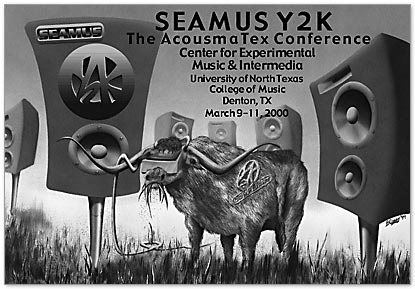Reviewed by Colby Leider (Princeton, New Jersey, USA)

The annual meeting of the Society for Electro-Acoustic Music in the United States (SEAMUS) brought over 150 composers, researchers, and educators to the University of North Texas (UNT) for three days of music, papers, and panel discussions. The conference was very well planned, and it successfully showcased local student talent as well as several new facilities at UNT: the reconfigurable 400-seat Lyric Theatre, which was particularly well-suited for the presentation of tape music, and the 1,066-seat Winspear Auditorium, in which a concert of music for tape and instruments was presented each evening.
Several corporations donated loudspeakers and audio equipment to the conference. The Lyric Theatre, for instance, was equipped with an arsenal of Genelec loudspeakers placed around the audience, allowing the music to be diffused with pristine clarity.
The tape music of several composers highlighted particularly well the conference theme of sound diffusion. Christopher Morgan, Co-Director of the conference, presented Graphomania 823, which eloquently captures in two sections the beauty of the mechanistic "techne" surrounding the act of writing. Craig Walsh’s Junket and Adrian Moore’s Superstrings were both exciting thrill rides of phantasmagoric gestural whirring. Paul Koonce’s subtle Breath and the Machine navigates the physical processes of instrumental sound-making in which sound diffusion emphasizes spatial acoustical response over sheer gestural motion. Conference Director Jon Nelson diffused Scatter, in which the differential velocities of sound objects is part of the compositional formalism. Other works by Jonty Harrison and Pete Stollery also addressed the conference theme in very effective but divergent ways.
Two concerts of tape music were presented in UNT’s Sky Theatre planetarium that featured choreographed star projections and computer-generated animation. Although the quality of the audio playback system there did not seem as high as the other venues, compositions by Terence Pender, Scott Wyatt, Mara Helmuth, and others worked particularly well.
Music for tape and solo instruments was also well-represented at the conference. Paul Rudy’s Degrees of Separation—Grandchild of Tree slowly incorporated the live tickling of a cactus amplified with contact microphones into a captivating texture. Douglas Geers’ Turnstile for violin and tape alternately treats beautifully simple melodies with moments of virtuosic exuberance. In A River from the Walls, for flute and tape, Linda Antas skillfully interlaces a particularly well-written flute part with electronic complements.
Two afternoon concerts highlighted compositions for mixed media. Neal Farwell’s The Violence of Architecture interleaves a video and audio narrative with mesmerizing repeated themes in both media. Several works employed extensive compositional treatment of the spoken word: Elemental Vamp, a collaboration between Allen Strange and video artist Gaben Chancellor, poetically portrays the plight of a "space-age" vampire, while Kristine Burns’ Underwear humorously and effectively captures a poem by Lawrence Ferlinghetti of the same name. Other works by Tom Lopez, UNT Composition Chair Joseph Klein, and conference Co-Director Elizabeth Hinkle-Turner each addressed other ways of approaching multimedia composition.
The papers and panel sessions focussed exclusively on ideas and research involving sound diffusion—ideas that were clearly reflected in much of the music presented at the conference. In discussions surrounding the papers and panels, two primary schools of thought seemed to emerge. In the first, multichannel presentation of sound is viewed as integral to the compositional dialectic; that is, some composers emphasize explicit presentation of compositional ideas in surround space whereby the space assumes a primary compositional dimension. In the second, space takes on more of an ambient nature. Here, the interest largely lies at the front of the space, with acoustic repercussions and "fill" in the rear and sides.
At the awards banquet, SEAMUS presented the 2000 Lifetime Achievement Award to composer Paul Lansky for his contributions to the field of electroacoustic music as a composer, programmer, and teacher. Elainie Lillios won the SEAMUS/ASCAP student commission contest for her tape composition, Arturo. Frances Richard of ASCAP presented Ms. Lillios with the award and a commission for a work to be presented at next year’s conference, to be held at Lousiana State University in Baton Rouge, Louisiana.
Overall, the conference was very successful, and the organizers should be congratulated on a job well done. Unfortunately, however, several composers presented their works at excessive volume levels, often reaching the audience for sustained periods at over 100 decibels. Occasionally, one could witness a number of audience members wearing earplugs or covering their ears. Perhaps our field should adopt a standard for maximum playback levels and adhere to it to make future conferences even more successful and enjoyable.